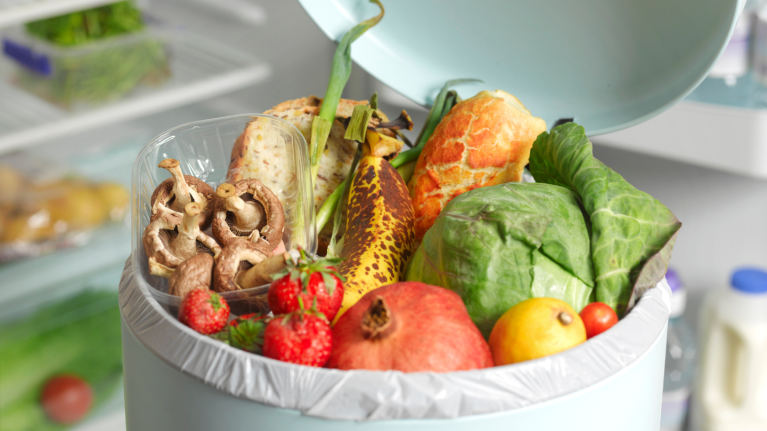
- Trends & Insights
- Nestlé In Society
How to Control and Reduce Waste
Reducing waste that goes to landfill is good business—and improves your brand image. Learn how Nestlé has achieved Zero-Waste-to-Landfill in its manufacturing facilities and operations and how you can too.
Striving to reduce and eliminate waste are ambitions that have been growing for the US food service industry in recent years. Overall waste reduction and diversion from landfill not only helps the environment, it can also enhance a brand’s image among consumers while also having a financial impact. In addition to a reduction in waste disposal costs, zero-waste policies can generate revenue from reselling recyclables, such as cooking oil. This in turn can reduce an organization’s environmental footprint and could ultimately help corporate social responsibility credentials.
According to the US Environmental Protection Agency (EPA), the United States landfilled 146 million tons of municipal solid waste in 2018, the largest share of which (24.1%) was generated by food. Plastics were next, at 18.5% of the total, followed by paper goods (11.8%), and metals (9.5%).
That’s why the mantra of Reduce, Reuse, and Recycle is key here. It’s a waste management strategy that forward-thinking food service operations have implemented, including many large colleges, hotels, healthcare institutions, supermarkets, and restaurants.
When it comes to food waste, the EPA’s Food Recovery Hierarchy is a good place to start. Although some levels may be not applicable or impractical for certain operations, the general guidelines are thought-provoking.
Level 1: Source Reduction
Reduce the Amount of Surplus Food at the Outset
- Use menu engineering to better utilize ingredients, such as making meatballs with protein trim or using broccoli and cauliflower cores for soup
- Offer smaller portions, whether with lower-priced small plates on a restaurant menu or smaller portions in an all-you-can-eat college dining facility
- Implement just-in-time cooking to prevent overproduction
- Conduct a waste audit to determine what’s going through the kitchen and what’s coming back uneaten
Level 2: Feed Hungry People
Donate Uneaten Food
- Donate nonperishable and unspoiled perishable foods to local food banks, soup kitchens, pantries, and shelters
- Maintain food safety standards and other best practices when donating food
- Check local resources to connect with organizations serving those in need
- Promote these activities to the local press, on your website, and in social media
- Take a tax deduction if applicable
Level 3: Feed Animals
Divert Food Scraps to Animal Feed
- Get information by contacting your local solid waste facility, county agricultural extension office, or public health agency (some states ban food donation for animal feed)
Level 4: Provide Food Waste for Industrial Uses
Turn Wasted Food Into Renewable Energy
- Send fats, oil, and grease to the rendering industry to be made into another product, converted to biofuels, or sent to an anaerobic digester
Level 5: Compost
Reduce the Impact of Wasted Food by Feeding the Soil
- Provide containers for compostables where they’re easy for the staff and customers, if applicable, to access them
- Use compostable paper goods and install signage instructing for their use at composting stations
- Send compost to local farms to grow more food
What Nestlé Is Doing
Nestlé has pledged to reduce food loss and waste through measures like responsible sourcing, careful planning, and zero waste for disposal, meaning that no waste will go to landfill or be incinerated without energy being recovered from the process. As of 2020, Nestlé worldwide had achieved zero waste for disposal status for 95% of its factories.
One example of our work is the Nestlé Professional Minor’s® factory in Cleveland, OH, which became a zero-waste-to-landfill facility in early 2015. Work began long before then to partner with suppliers and implement policies to reduce waste throughout the operation. From packaging to recycling, from efficient heating and cooling systems in offices and factories to timers on lights, Nestlé monitors and works to improve its manufacturing processes to reduce waste, minimize water consumption and lower carbon emissions.
The last step in the zero waste to landfill process was determining what to do with the materials left in the compactors after all other waste material was disposed. After much research, the company’s environmental teams determined that the best way to eliminate that waste was to incinerate and turn it into energy.
The process burns the trash in a high-efficiency incinerator that produces almost no pollution. The heat from the incineration process produces steam which fuels generators and produces electricity which can then be sold back to the company’s utility provider. While the process costs about the same amount as landfilling due to increased transportation costs, it does serve to remove waste from landfills, which is better for the environment and worth the increased costs.
By the Numbers:
With approximately 3.8 million pounds of waste in the Minor’s factory in 2021, none goes to landfill
- Roughly 80% of all waste is recycled, composted, or bio-recovered; the remaining 20% is incinerated for energy recovery
- 0.4 million pounds of waste byproducts are used to generate bio-energy
- 100,600 pounds of recovered food waste and nonconforming goods are sent out for composting
- 1.2 million pounds of material are recycled annually (plastic, cardboard, cans, paper, metal, wood)
- 1.1 million pounds of material is utilized for energy production
